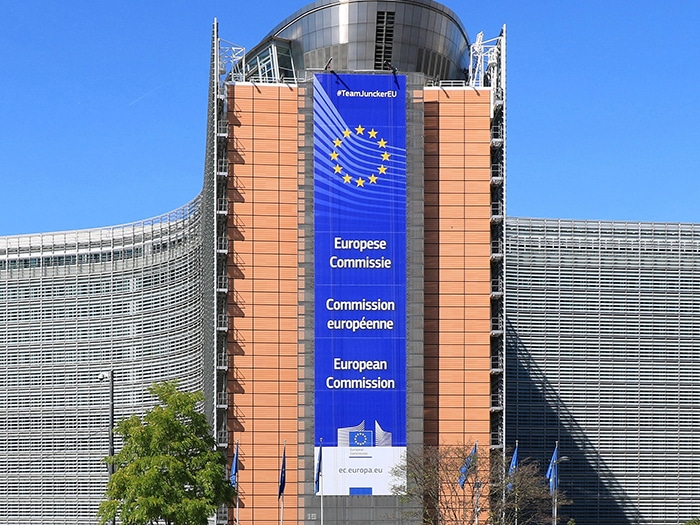EC’s Union Database plan could limit biofuel availability to ships
EC's Union Database plan could limit biofuel availability to ships Marine Log


The European Union’s Union Database (UDB) Plans Raise Concerns
Written by Nick Blenkey

EC Headquarters [Image source: EmDee, CC BY-SA 4.0, via Wikimedia Commons]
The European Union is setting up a Union Database (UDB) of biofuels. The database aims to ensure the traceability of liquid and gaseous biofuels that are eligible for being counted towards the share of renewable energy in the transportation sector in any EU member state. One aspect of the European Commission’s plans for the UDB is causing “deep concerns” to both the Methanol Institute (MI) and SEA-LNG, key representatives of the methanol and liquefied natural gas (LNG) industries respectively.
The Commission has noted its intention to exclude the automatic certification of biomethane and biomethanol-based fuels produced through mass balance chain of custody in third-party countries outside the EU gas grids within the Union Database (UDB).
The Methanol Institute and SEA-LNG say that this exclusion will severely limit the use of these critical fuels in decarbonizing intra-European and international maritime transport even if these fuels were produced in accordance with EU regulations under the EU’s Renewable Energy Directive (RED).
Both the Methanol Institute and SEA-LNG are particularly concerned about the potential impacts of these measures on competitiveness and international trade dynamics. They say that if this exclusion from the UDB materializes, it will create a trade barrier that threatens to impede the importation of biomethane and biomethanol into the European Union, limiting the availability and increasing the costs of these fuels to the bunkering industry in Europe.
It may also disqualify such fuels produced using a mass balance chain of custody from non-EU gas grids, when bunkered in non-European ports for use by vessels calling at European ports. Consequently, these fuels may not be able to generate credits under EU ETS and FuelEU Maritime.
In response to these challenges, MI and SEA-LNG call for the recognition of biomethane and biomethanol-based fuels produced using a mass balance chain of custody from non-EU gas grids under the UDB. Yesterday, they sent a joint letter proposing an urgent meeting between our representatives and those of the European Commission to discuss necessary amendments to ensure a sustainable and competitive energy future for the European maritime sector.
RELATED ARTICLES
SDGs, Targets, and Indicators
1. Which SDGs are addressed or connected to the issues highlighted in the article?
- SDG 7: Affordable and Clean Energy
- SDG 9: Industry, Innovation, and Infrastructure
- SDG 13: Climate Action
- SDG 17: Partnerships for the Goals
The issues highlighted in the article are connected to the SDGs mentioned above. The focus is on promoting renewable energy sources, reducing carbon emissions, and fostering international partnerships for sustainable development.
2. What specific targets under those SDGs can be identified based on the article’s content?
- SDG 7.2: Increase substantially the share of renewable energy in the global energy mix.
- SDG 9.4: Upgrade infrastructure and retrofit industries to make them sustainable.
- SDG 13.2: Integrate climate change measures into national policies, strategies, and planning.
- SDG 17.16: Enhance the global partnership for sustainable development.
The article highlights the need to ensure the traceability of biofuels and promote their use in the transportation sector. This aligns with the targets mentioned above, which aim to increase the share of renewable energy, upgrade infrastructure for sustainability, integrate climate change measures, and enhance global partnerships.
3. Are there any indicators mentioned or implied in the article that can be used to measure progress towards the identified targets?
- Percentage of renewable energy in the transportation sector
- Number of biofuels eligible for counting towards the share of renewable energy
- Extent of traceability of liquid and gaseous biofuels
- Number of international trade barriers related to biofuels
The article implies the need to measure the percentage of renewable energy in the transportation sector, the number of biofuels eligible for counting towards the share of renewable energy, the extent of traceability of biofuels, and the number of trade barriers affecting biofuels. These indicators can be used to track progress towards the identified targets.
SDGs, Targets, and Indicators
| SDGs | Targets | Indicators |
|---|---|---|
| SDG 7: Affordable and Clean Energy | Increase substantially the share of renewable energy in the global energy mix. | Percentage of renewable energy in the transportation sector |
| SDG 9: Industry, Innovation, and Infrastructure | Upgrade infrastructure and retrofit industries to make them sustainable. | Number of biofuels eligible for counting towards the share of renewable energy |
| SDG 13: Climate Action | Integrate climate change measures into national policies, strategies, and planning. | Extent of traceability of liquid and gaseous biofuels |
| SDG 17: Partnerships for the Goals | Enhance the global partnership for sustainable development. | Number of international trade barriers related to biofuels |
Behold! This splendid article springs forth from the wellspring of knowledge, shaped by a wondrous proprietary AI technology that delved into a vast ocean of data, illuminating the path towards the Sustainable Development Goals. Remember that all rights are reserved by SDG Investors LLC, empowering us to champion progress together.
Source: marinelog.com

Join us, as fellow seekers of change, on a transformative journey at https://sdgtalks.ai/welcome, where you can become a member and actively contribute to shaping a brighter future.







